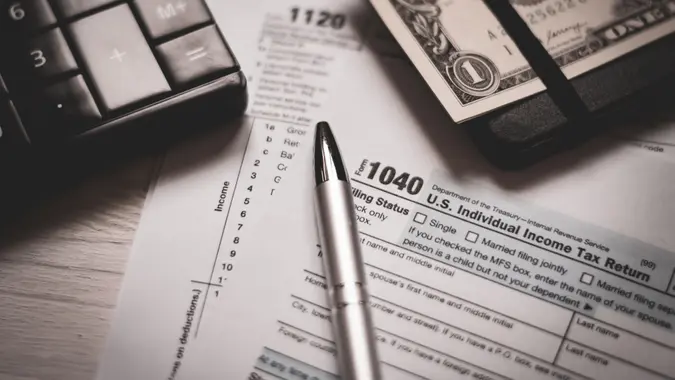What Is Federal vs. State Income Tax?

Commitment to Our Readers
GOBankingRates' editorial team is committed to bringing you unbiased reviews and information. We use data-driven methodologies to evaluate financial products and services - our reviews and ratings are not influenced by advertisers. You can read more about our editorial guidelines and our products and services review methodology.

20 Years
Helping You Live Richer

Reviewed
by Experts

Trusted by
Millions of Readers
Although you might cringe at the thought of paying taxes on your hard-earned income, taxes are what keep federal and state governments in business, paying for the services you rely on. For the U.S. federal government, a majority of the revenue comes from income taxes, and most state governments rely on them as well.
Check Out: What To Do If You Owe Back Taxes to the IRS
To understand what income tax is and how it works, take a look at this breakdown.
What Is Federal Income Tax?
Federal income taxes are taxes imposed by the federal government on the annual earnings of individuals, corporations, trusts and other legal entities. The government uses all that money to pay for federal programs including Social Security, defense and security, and major health programs such as Medicare and Medicaid.
The Internal Revenue Service is the federal agency responsible for administering federal income tax. It operates under the U.S. Department of the Treasury to collect and process tax payments and assist taxpayers in understanding and meeting their tax obligations.
What Is the Difference Between Federal Income Tax and State Income Tax?
State and federal income taxes serve the same purpose — to raise the revenue governments need to operate and provide services to their citizens. The difference is that not all states impose income tax, and each one that does decides for itself what type of income to tax and at what rate to tax it.
Among the 43 states that have income tax, two exclude wage and salary income, taxing dividends and interest (New Hampshire) or capital gains (Washington) instead, according to the Tax Foundation. And while 29 states and Washington, D.C., have progressive tax rates similar to the federal government’s, 14 states impose a flat tax rate. State tax rates are typically lower than federal rates.
Who Has To Pay Federal Income Tax?
Most American citizens and permanent residents who work in the U.S. must pay federal income tax if their income exceeds certain gross income thresholds. The thresholds vary according to filing status.
For tax year 2023, the gross income threshold for each filing status is as follows:
- Single: $13,850 ($15,700 if age 65 or older)
- Head of household: $20,800 ($22,650 if 65 or older)
- Married filing jointly: $27,700 ($29,200 if one spouse is 65 or older, $30,700 if both spouses are 65 or older)
- Married filing separately: $5
- Qualifying surviving spouse: $27,700 ($29,200 if 65 or older)
How Is Federal Income Tax Calculated?
Your federal income tax calculation is based on your taxable income — that is, your gross income less adjustments, deductions and credits. The tax is progressive, so your tax rate increases as your earnings increase.
To calculate your tax, look at the IRS rate table below to find your tax bracket. A tax bracket is the range of earnings to which a particular tax rate applies.
Your bracket is the one that represents the last dollar you earned. If, for example, you earned $75,000 in 2023, your income would fall in the 22% tax bracket. However, federal income tax is progressive — rates are layered, so you pay less tax on your first dollar of income than you do on your last.
In the 2023 tax rate schedule below, you’ll see each bracket and the rate that applies to it. For that $75,000 in income, you’d pay:
- 10% on the first $11,000 in income: $1,100
- 12% on the next $33,724 ($44,725 – $11,001): $4,047 (rounded)
- 22% on the remaining $30,274 ($75,000 – $44,726): $6,660 (rounded)
The total tax is $11,807 ($1,100 + $4,047 + $6,660).
2023 Tax Brackets and Rates
| Rate | Single and Married Filing Separately | Married Filing Jointly | Head of Household |
|---|---|---|---|
| 10% | $0 to $11,000 | $0 to $22,000 | $0 to $15,700 |
| 12% | $11,001 to $44,725 | $22,001 to $89,450 | $15,701 to $59,850 |
| 22% | $44,726 to $95,375 | $89,451 to $190,750 | $59,851 to $95,350 |
| 24% | $95,376 to $182,100 | $190,751 to $346,200 | $95,351 to $182,100 |
| 32% | $182,101 to $231,250 | $364,201 to $462,500 | $182,101 to $231,250 |
| 35% | $231,251 to $578,125 for single filers, $231,251 to $346,875 for married separate filers | $462,501 to $693,750 | $231,251 to $578,100 |
| 37% | $578,126 and up for single filers, $346,876 and up for married separate filers | $693,751 and up | $578,101 and up |
FAQ
The federal government and most state governments impose income taxes, but the federal government's tax system tends to be more complicated. These frequently asked questions can help you sort out how it works.- What is the FICA tax rate?
- The FICA tax rate is 15.3% of your gross wages. The tax is divided between Social Security, which receives 6.2%, and Medicare, which receives 1.45%. If you're a W-2 employee, your employer pays half.
- What is the capital gains tax rate?
- Short-term capital gains are taxed at your federal income tax rate. Long-term capital gains tax rates vary from 0% to 20%, depending on your income.
- Where can I find IRS tax brackets?
- Is it better to itemize or take the standard deduction on my federal income tax return?
- You’ll have to calculate your deductions both ways to see which is the most beneficial. The 2023 tax write-off for people who take the standard deduction is $13,850 for single and individual filers, $27,700 for married joint filers and $20,800 for heads of household.
- How long does it take to get a tax refund?
- Most taxpayers receive their refunds within 21 days, according to the IRS, but how long it takes to get your refund depends on whether you request a check or direct deposit (direct deposit is faster) and whether your return requires additional review.
Taylor Bell contributed to the reporting for this article.
Our in-house research team and on-site financial experts work together to create content that’s accurate, impartial, and up to date. We fact-check every single statistic, quote and fact using trusted primary resources to make sure the information we provide is correct. You can learn more about GOBankingRates’ processes and standards in our editorial policy.
- IRS. 2024. "The agency, its mission and statutory authority."
- IRS. 2024. "Who needs to file a tax return."
- IRS. 2024. "Publication 501."
- IRS. 2024. "Credits and deductions for individuals."
- IRS. 2024. "Tax Season Refund Frequently Asked Questions."
- Tax Foundation. 2024. "State Individual Income Tax Rates and Brackets, 2024."
- Fidelity. "2023 and 2024 capital gains tax rates."
 Written by
Written by  Edited by
Edited by 

























